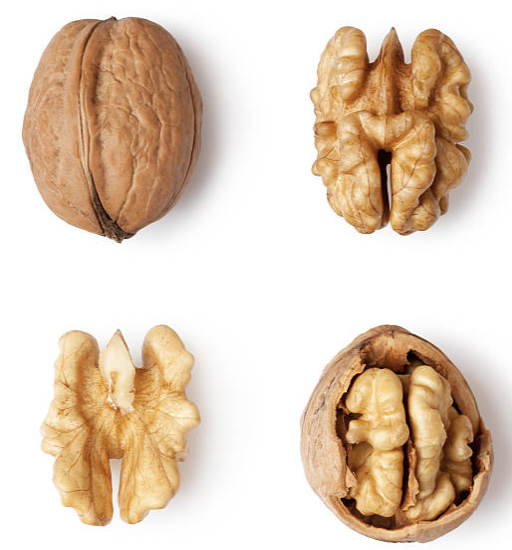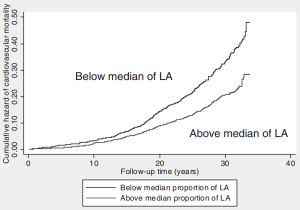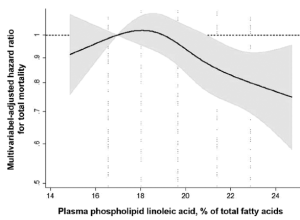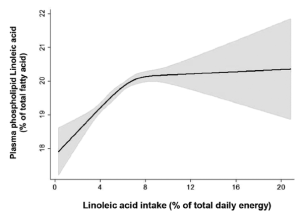Linoleic acid (C18:2, n-6) is an essential fatty acid that must be obtained from the diet, because our body can’t make it. How much linoleic acid should we eat every day for optimal health? To answer this question, I’ll investigate the association between circulating levels of linoleic acid with all-cause mortality risk, followed by identification of a corresponding dietary intake. Let’s have a look!
First, are circulating levels of linoleic acid associated with all-cause mortality risk? 4 studies have investigated this issue:
- In a 15-year study of 1,551 middle-aged men (average age, 52y), increased circulating linoleic acid was associated with significantly reduced all-cause mortality risk in 3 of the 4 multivariable-adjusted models (Laaksonen et al. 2005).
- In a 15-year study of 4,232 older adults (60y) elevated circulating linoleic acid was associated with significantly reduced all-cause mortality risk in men, but not women (Marklund et al. 2015).
- In a 34-year study of 2,009 middle-aged men (average age, 50y) increased circulating linoleic acid was associated with significantly decreased risk of all-cause mortality (Warensjö et al. 2008). For example, shown below is the association between the risk of death from cardiovascular-related disease with the circulating linoleic acid concentration. At both 20 and 30 years after study onset, subjects that had circulating linoleic values above the median had approximately half of the mortality risk from CVD, when compared with below-median values for linoleic acid.
- In a 13-year study that included both older men and women (average age, 74y), and, more subjects (2,792) than the studies of Laaksonen and Warensjöet combined, plasma phospholipid percentages of linoleic acid greater than ~21-24% were associated with significantly reduced all-cause mortality risk:
Colectively, these 4 studies show that increased circulating levels of linoleic acid are associated with reduced all-cause mortality risk. How much linoleic acid should we eat to achieve optimal circulating values? In other words, what dietary intake of linoleic acid corresponds to 21%+ of plasma phospholipid linoleic acid? Based on the data below, dietary intakes of linoleic acid that are greater than 14% of total calories are associated with circulating linoleic acid values of 21% (Wu et al. 2014).
On my ~2300 calorie diet, that translates into 322 calories (36g) from linoleic acid. I get a significant amount of dietary linoleic acid from one of the best linoleic acid food sources, walnuts, which contain 5.8 grams of linoleic acid per 100 calories (see Lipids, C18:2, http://ndb.nal.usda.gov/ndb/foods/show/3690?fg=&man=&lfacet=&count=&max=&qlookup=&offset=&sort=&format=Full&reportfmt=other&rptfrm=&ndbno=&nutrient1=&nutrient2=&nutrient3=&subset=&totCount=&measureby=&_action_show=Apply+Changes&Qv=.152&Q6919=1&Q6920=1&Q6921=1&Q6922=1&Q6923=1&Q6924=1).
Just using walnuts alone, I’d need ~700 calories per day to reach 14% dietary linoleic acid! Although I’m always interested in dietary strategies that may reduce all-cause mortality risk, allocating ~30% of my daily calories to only walnuts is not ideal for my high-fiber approach to health (https://atomic-temporary-71218033.wpcomstaging.com/2015/07/17/on-a-paleo-diet-not-if-you-fiber-intake-is-less-than/), nor would it satiate me, as high-volume vegetable meals are best for that. A more reasonable dietary linoleic acid target (for now) is ~8%, the point at which plasma linoleic acid mostly plateaus (see the plot above). 8% on my 2300 calorie diet translates into 20 grams of linoleic acid per day. I should note that I also get a good amount of linoleic acid (6.4 grams) from the 30 grams of sesame seeds that goes into my giant salad’s dressing, which I eat 2-3x per week. When combined with ~300 calories from walnuts/day, that gets me to at least 8% of my daily calories from linoleic acid.
If you’re interested, please have a look at my book!
References:
Laaksonen DE, Nyyssönen K, Niskanen L, Rissanen TH, Salonen JT. Prediction of cardiovascular mortality in middle-aged men by dietary and serum linoleic and polyunsaturated fatty acids. Arch Intern Med. 2005 Jan 24;165(2):193-9.
Marklund M, Leander K, Vikström M, Laguzzi F, Gigante B, Sjögren P, Cederholm T, de Faire U, Hellénius ML, Risérus U. Polyunsaturated Fat Intake Estimated by Circulating Biomarkers and Risk of Cardiovascular Disease and All-Cause Mortality in a Population-Based Cohort of 60-Year-Old Men and Women. Circulationz 2015 Aug 18;132(7):586-94.
Warensjö E, Sundström J, Vessby B, Cederholm T, Risérus U. Markers of dietary fat quality and fatty acid desaturation as predictors of total and cardiovascular mortality: a population-based prospective study. Am J Clin Nutr. 2008 Jul;88(1):203-9.
Wu JH, Lemaitre RN, King IB, Song X, Psaty BM, Siscovick DS, Mozaffarian D. Circulating omega-6 polyunsaturated fatty acids and total and cause-specific mortality: the CardiovascularHealth Study. Circulation. 2014 Oct 7;130(15):1245-53



